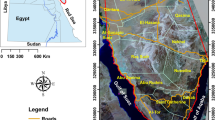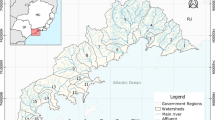Abstract
Flood susceptibility is associated with a variety of factors. A hydrologic study of Wadi Al-Sail Al-Kabir was conducted based on morphometric analysis and hydrological indices. The current study aimed to apply morphometric analysis and multi-criteria decision analysis based on hydrological indices for flash flood risk assessment. RS and GIS were used to obtain morphological parameters. Thirty-six parameters were evaluated and categorized to basin geometry, drainage texture, drainage network, and relief characteristics. Spatial analysis was applied in a GIS environment for flash flood assessment, where 11 related hydrological indices were selected: the sediment transport index, stream power index, terrain ruggedness index, topographic wetness index, topographic position index, normalized difference vegetation index, distance to road, precipitation, elevation, slope, and drainage density. Each index was weighted based on its relative significance using an analytical hierarchy process. It was found that the area is 255.13 km2 (large area) and the wadi is related to the 5th order, consisting of 818 streams with a total length of 564.8 km. Finally, the generated map shows that approximately 40.8% of the wadi classified as high- and very high-risk areas, and 39% as moderate-risk areas. Using the generated map as evidence, planners can prepare an appropriate land-use policy to reduce the threat of flooding.







Similar content being viewed by others

References
Asode AN, Sreenivasa A, Lakkundi TK (2016) Quantitative morphometric analysis in the hard rock Hirehalla sub-basin, Bellary and Davanagere Districts, Karnataka, India using RS and GIS. Arab J Geosci 9(5):381
Bannari A, Ghadeer A, El-Battay A, Hameed NA, Rouai M (2017) Detection of areas associated with flash floods and erosion caused by rainfall storm using topographic attributes, hydrologic indices, and GIS. Global changes and natural disaster management: Geo-information technologies. Springer, Cham, pp 155–174
Beven KJ, Kirkby MJ (1979) A physically based, variable contributing area model of basin hydrology/Un modèle à base physique de zone d’appel variable de l’hydrologie du bassin versant. Hydrol Sci J 24(1):43–69
Burrough PA, McDonnell RA, Lloyd CD (2015) Principles of geographical information systems. Oxford University Press
Chen Y, Yu J, Khan S (2010) Spatial sensitivity analysis of multi-criteria weights in GIS-based land suitability evaluation. Environ Modell Softw 25(12):1582–1591. https://doi.org/10.1016/j.envsoft.2010.06.001
Chorley RJ, Malm DEG, Pogorzelski HA (1957) A new standard for estimating drainage basin shape. Am J Sci 255(2):138–141
Dawod GM, Mirza MN, Al-Ghamdi KA (2011) GIS-based spatial mapping of flash flood hazard in Makkah City, Saudi Arabia. J Geogr Inf Syst 3(03):225
El Shinnawy I, Bestawy A, Tahawy TE (2017) Assessment and management of flash floods for sustainable development in Al-Sail Al Kabir area, Kingdom of Saudi Arabia. Int J Appl Eng Res 12:2807–2814
El-Rawy M, Elsadek WM, De Smedt F (2022a) Flash flood susceptibility mapping in Sinai Egypt using hydromorphic data principal component analysis and logistic regression. In Water. https://doi.org/10.3390/w14152434
El-Rawy M, Elsadek WM, De Smedt F (2022b) Flood hazard assessment and mitigation using a multi-criteria approach in the Sinai Peninsula Egypt. Nat Hazards. https://doi.org/10.1007/s11069-022-05551-0
Elsadek WM, Ibrahim MG, Mahmod WE (2019a) Runoff hazard analysis of Wadi Qena Watershed, Egypt based on GIS and remote sensing approach. Alex Eng J 58(1):377–385
Elsadek WM, Ibrahim MG, Mahmod WE, Kanae S (2019b) Developing an overall assessment map for flood hazard on large area watershed using multi-method approach: case study of Wadi Qena watershed. Egypt Natural Hazards 95(3):739–767
Faniran A (1968) The index of drainage intensity: a provisional new drainage factor. Aust J Sci 31(9):326–330
Farhan Y (2017) morphometric assessment of Wadi Wala Watershed, Southern Jordan using ASTER (DEM) and GIS. J Geogr Inf Syst 9(2):158–190
Fenta AA, Yasuda H, Shimizu K, Haregeweyn N, Woldearegay K (2017) Quantitative analysis and implications of drainage morphometry of the Agula watershed in the semi-arid northern Ethiopia. Appl Water Sci 7(7):3825–3840. https://doi.org/10.1007/s13201-017-0534-4
Geiger R (1954) Klassifikation der klimate nach W. Köppen. Landolt-Börnstein–Zahlenwerte Und Funktionen Aus Physik. Chemie, Astronomie, Geophysik Und Technik 3:603–607
Gregory KJ, Walling DE (1973) Drainage basin form and process.
Haggett, P. (1966). Locational analysis in human geography.
Horton RE (1932) Drainage-basin characteristics. EOS Trans Am Geophys Union 13(1):350–361
Horton RE (1945) Erosional development of streams and their drainage basins; hydrophysical approach to quantitative morphology. Geol Soc Am Bull 56(3):275–370
Hossain MS, Das NG (2010) GIS-based multi-criteria evaluation to land suitability modelling for giant prawn (Macrobrachium rosenbergii) farming in Companigonj Upazila of Noakhali Bangladesh. Comput Electr Agric 70(1):172–186. https://doi.org/10.1016/j.compag.2009.10.003
Lykoudi, E., & Zarris, D. (2004). The influence of drainage network formation and characteristics over a catchment’s sediment yield.
Malik S, Pal SC, Chowdhuri I, Chakrabortty R, Roy P, Das B (2020) Prediction of highly flood prone areas by GIS based heuristic and statistical model in a monsoon dominated region of Bengal Basin. Remote Sens Appl 19:100343
Miller, V. C. (1953). Quantitative geomorphic study of drainage basin characteristics in the Clinch Mountain area, Virginia and Tennessee. Technical Report (Columbia University. Department of Geology); No. 3.
Mojaddadi H, Pradhan B, Nampak H, Ahmad N, Ghazali AH (2017) Ensemble machine-learning-based geospatial approach for flood risk assessment using multi-sensor remote-sensing data and GIS. Geomat Nat Haz Risk 8(2):1080–1102
Moore ID, Grayson RB, Ladson AR (1991) Digital terrain modelling: a review of hydrological, geomorphological, and biological applications. Hydrol Process 5(1):3–30
Moore ID, Gessler PE, Nielsen GAE, Peterson GA (1993) Soil attribute prediction using terrain analysis. Soil Sci Soc Am J 57(2):443–452
Mueller JE (1968) An introduction to the hydraulic and topographic sinuosity indexes. Ann Assoc Am Geogr 58(2):371–385
Nekhay O, Arriaza M, Guzmán-Álvarez JR (2009) Spatial analysis of the suitability of olive plantations for wildlife habitat restoration. Comput Electr Agric 65(1):49–64. https://doi.org/10.1016/j.compag.2008.07.012
Panhalkar SS, Mali SP, Pawar CT (2012) Morphometric analysis and watershed development prioritization of Hiranyakeshi Basin in Maharashtra India. Int J Environ Sci 3(1):525–534
Pareta K, Pareta U (2011) Quantitative morphometric analysis of a watershed of Yamuna basin, India using ASTER (DEM) data and GIS. Int J Geom Geosci 2(1):248
Rahaman MF, Jahan CS, Arefin R, Mazumder QH (2017) Morphometric analysis of major watersheds in Barind Tract, Bangladesh: a remote sensing and GIS-based approach for water resource management. Hydrology 5(6):86–95
Rahmati O, Kalantari Z, Samadi M, Uuemaa E, Moghaddam DD, Nalivan OA, Destouni G, Bui DT (2019) GIS-based site selection for check dams in watersheds: Considering geomorphometric and topo-hydrological factors. Sustainability (switzerland). https://doi.org/10.3390/su11205639
Rai PK, Mohan K, Mishra S, Ahmad A, Mishra VN (2017) A GIS-based approach in drainage morphometric analysis of Kanhar River Basin India. Appl Water Sci 7(1):217–232
Rather AF, Ahmed R, Wani GF, Ahmad ST, Dar T, Javaid S, Ahmed P (2022) Mapping of groundwater potential zones in Pohru Watershed of Jhelum Basin-Western Himalaya India using integrated approach of remote sensing GIS and AHP. Earth Sci Inf. https://doi.org/10.1007/s12145-022-00824-5
Riley SJ, DeGloria SD, Elliot R (1999) A terrain ruggedness index that qauntifies topographic heterogeneity. Int J Sci 5(1–4):23–27
Saaty, T. L. (1990). Multicriteria decision making: the analytic hierarchy process: planning, priority setting resource allocation.
Saud MA (2010) Assessment of flood hazard of Jeddah area 2009, Saudi Arabia. J Water Resour Prot 02(09):839–847. https://doi.org/10.4236/jwarp.2010.29099
Schumm SA (1956) Evolution of drainage systems and slopes in badlands at Perth Amboy, New Jersey. Geol Soc Am Bull 67(5):597–646
Singh O, Sarangi A, Sharma MC (2008) Hypsometric integral estimation methods and its relevance on erosion status of north-western lesser Himalayan watersheds. Water Resour Manage 22(11):1545–1560
Smith KG (1958) Erosional processes and landforms in badlands national monument, South Dakota. Geol Soc Am Bull 69(8):975–1008
Sreedevi PD, Owais S, Khan HH, Ahmed S (2009) Morphometric analysis of a watershed of South India using SRTM data and GIS. J Geol Soc India 73(4):543–552
Srinivasa Vittala S, Govindaiah S, Honne Gowda H (2004) Morphometric analysis of sub-watersheds in the pavagada area of Tumkur district, South India using remote sensing and gis techniques. J Indian Soc Remote Sens 32(4):351. https://doi.org/10.1007/BF03030860
Strahler AN (1953) Revisions of Horton’s quantitative factors in erosional terrain. Trans Am Geophys Union 34:345
Strahler AN (1957) Quantitative analysis of watershed geomorphology. EOS Trans Am Geophys Union 38(6):913–920
Strahler, A. N. (1964). Quantitative geomorphology of drainage basin and channel networks. Handbook of Applied Hydrology.
Suma BN, Srinivasa CV (2017) A study on morphometric parameter of a watershed for sustainable water conservation. Int J Civ Eng Technol 8(9):271–278
Vaidya OS, Kumar S (2006) Analytic hierarchy process: an overview of applications. Eur J Oper Res 169(1):1–29. https://doi.org/10.1016/j.ejor.2004.04.028
Valle Junior RF, Varandas SGP, Sanches Fernandes LF, Pacheco FAL (2014) Environmental land use conflicts: a threat to soil conservation. Land Use Policy 41:172–185. https://doi.org/10.1016/j.landusepol.2014.05.012
Acknowledgements
The first author would like to thank the Tokyo Institute of Technology for hosting him as a visiting fellow. The researchers would like to acknowledge the Deanship of Scientific Research, Taif University, for supporting this work. The authors appreciate anonymous reviewers for their constructive comments that helped them to improve the paper.
Funding
This research received no external funding.
Author information
Authors and Affiliations
Contributions
W.M.E. was involved in conceptualization; methodology; writing—original draft preparation; and writing—reviewing and editing; and A.H.A. was responsible for supervision. All authors have read and agreed to the published version of the manuscript. All authors have read and agreed to the published version of the manuscript.
Corresponding author
Ethics declarations
Conflict of interest
The authors declare they have no conflict of interest.
Additional information
Publisher's Note
Springer Nature remains neutral with regard to jurisdictional claims in published maps and institutional affiliations.
Rights and permissions
Springer Nature or its licensor (e.g. a society or other partner) holds exclusive rights to this article under a publishing agreement with the author(s) or other rightsholder(s); author self-archiving of the accepted manuscript version of this article is solely governed by the terms of such publishing agreement and applicable law.
About this article
Cite this article
Elsadek, W.M., Almaliki, A.H. Integrated hydrological study for flash flood assessment using morphometric analysis and MCDA based on hydrological indices—Al-Sail Al-Kabir, KSA. Nat Hazards (2024). https://doi.org/10.1007/s11069-024-06450-2
Received:
Accepted:
Published:
DOI: https://doi.org/10.1007/s11069-024-06450-2






